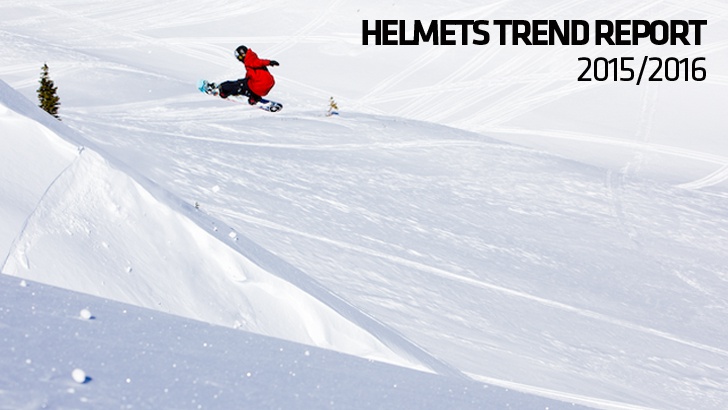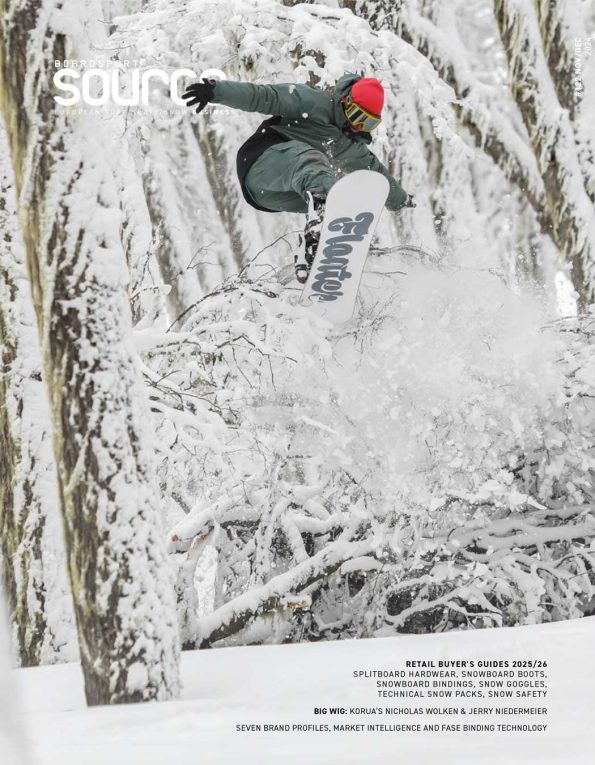Helmets Trend Report 15/16
 |
| Pic: Bern |
Considering the massive variety of brands and technologies in the snow helmet segment, which products are a ‘safe’ bet for retailers on Fall/Winter 2015/16 order sheets? Our trend report has the answers. By Dirk Vogel.
Born out of youthful rebellion, early snowboard culture wanted no part in rules and regulations. Not to mention helmets and safety gear. Those were for skiers, and jocks (widely considered synonymous at the time). While snowboarders were banned from many resorts in the early 1990s, they took to the slopes with hardly more than a beanie covering their heads. It’s safe to say that times are changing.
In recent surveys, health professionals in Austria estimated helmet use among snowboarders and skiers in their country between 60–70 per cent, while the number is 84 per cent in Switzerland. The traumatic skiing accident of Formula 1 icon Michael Schumacher also sent a powerful reminder: Without a helmet, responders at the Grenoble hospital concurred, the multiple world champion would not be alive.
Snow helmet companies old and new are heeding the call: “We founded our company because we know we can get better technologies to save more lives. This is our rule number one!” said David Assyag, co-founder of upstart brand KALI protectives.
 |
| Bern |
THE MARKET: MORE HEADS TO COVER
From a retail perspective, helmet adoption levels up to a staggering 84 per cent might seem daunting. Who still needs one? Practically everybody, at some point, says Mattia Berardi, Giro’s EMEA Snow Manager: “Helmets don’t last forever and crashes, drops, dings, and normal wear and tear all affect your helmet and can be a cause for replacement. A good rule of thumb is to replace your helmet every three years or before.” Replacing a helmet after a crash should also be, well, a no-brainer.
While certified helmets start as low as €30, most of the action is at mid-level price points, with a recent surge in the premium segment. “We see that consumers are really focusing on the €80-130 and €160-200 price point helmets. It has been interesting, but consumers awareness to product features in the snow category are really starting to increase,” said Graham Sours, Helmet Product Manager at Smith Optics, adding: “With this increased awareness to helmet tech features, consumers are willing to spend a little more money on premium products that represent an improved protection component.” Stephanie Fontenille, Goggles & Helmets product manager at Quiksilver also notes: “People are responding more and more to premium products.”
TECHNOLOGIES: LIGHTER AND STRONGER
The arms race for the ultimate helmet – mainly a combination of light weight and proven strength – has companies engineering from the ground up. Oscar Huss, Product Director at POC notes: “The award-winning Fornix is a lightweight, aramid reinforced and well-ventilated helmet. By applying aramid strings and moulding them together with the foam liner, it was possible to develop a lightweight helmet while maintaining structural stability and a high level of protection.”
“For Sweet Protection, the use of carbon fibre is essential in the engineering of our best performing helmets and their ability to distribute impact forces,” said Åsmund Thorsen, Marketing coordinator at SWEET Protection. The company takes a 360-degree view of safety: “The sides have integrated ABS ‘side impact hard shells’ that reinforce the side construction, while securely attaching the webbing and ear pads.”
Through Anon’s partnership with G-From, the brand harness their materials to provide and armour to their helmet, which dissipates nearly all energy from a blow and instantaneously returns to its lightweight and flexible state.
Next season, Head will be introducing FLEXCORE Technology: “A soft helmet core matching the highest safety standards combined with never before seen wearing comfort and fit,” said Max Thurner, Intl. Marketing Manager Snowboard & Protection. Women’s brand Roxy is also blending safety and comfort with the Power Powder: “It can offer one of the best comfortable helmet shells in the market. Super low profile on the head, with mid-price level,” said Stephanie Fontenille.
PREPARED FOR IMPACT
One particular technology is sending ripples across the industry: MIPS (Multi-Directional Impact Protection System), a slip-plane system within the helmet designed to rotate inside the helmet to slow down the forces of impact. Next season, MIPS is adopted by a wide variety of brands, including Brunotti, Giro, Sweet, POC, Giro, and also Smith Optics.
David at KALI also has riders covered when head meets snow: “Our high-range models are offering cone head technologies, this means that the EPS liner in charge of the impact absorption is now able to distribute the energy laterally and not anymore in the direction of the user brain.” Federico Merle is proud of his company’s impact system: “The honeycomb shape of the embedded Slytech 2nd SKiN XT within the EPS foam promotes multidirectional dissipation of energy as the force encounters our unique protection layers.”
Instead of re-inventing the wheel, Bliss is banking on proprietary impact technology: “A couple of years ago we invented the ARG. For Bliss this is the future of shock absorbing technology. We are going to fiddle about with a ARG helmet but at the moment we are not in the maturity phase,” said Matthias Ascherl, owner of Bliss.
 |
| Head |
INTEGRATION: COMBINED STRENGTHS
Combining advanced helmets with innovative goggle design means adding strength to strength. Across the board, leading companies offer seamless integration, including Quiksilver: “The Skylab can offer the perfect product combo with our Hubble goggle, and you can wear the perfect combo.” Josh at Bern announced that next season, the brand will be, “dropping goggles for the first time, and using some very unique foams. We have engineered an amazing integration with our helmets and goggles.” Brunotti adds a big variety in colours to the mix: “This way you can mix and match your own combination. Because of the fit system in the neck you can adjust the helmet size,” adds Lonneke Mulder, Marketing Manager Brunotti Europe.
Technology is the next frontier of integration, with brands across the board offering audio combinations, including Smith (with Skullcandy), POC (Beats by Dre) and Giro (Outdoor Technology). Mattia at Giro boasts: “We have also been a pioneer of GoPro camera integration with the Edit helmet and new women’s Flare models, and Giro is the only helmet offering a co-branded mount and compatibility approved by GoPro.” Smartphones are hopping on for the ride as well with the Head Sensor BT Runtastic helmet in cooperation with the Runtastic app connected via Bluetooth.
Smart about the environment, Picture Organic Clothing teamed up with KALI for the Eco helmet, featuring an inner shell from 100% recycled EPS from Japanese car manufacturing, a natural, corn-based hard shell, and lining made from recycled PET bottles: “We have re-invented the industrial helmet process and the vision behind a helmet. Now, wearing a Picture helmet is much more than wearing a simple protection, it is also being part of an environmental movement,” said Julien Durant at Picture.
 |
| KALI |
AESTHETICS: NAVY SEALS VS. WU-TANG
Stylistically, next season’s helmets are leaning toward skateboard helmets with their lightweight, form-fitting shell design, often with the addition of slightly tapered visors. TSG easily achieves this look by drawing on the brand’s skateboarding roots: “The Gravity is the winter version of our all-time favourite skate helmet, the Evolution. It’s a clean design with an anatomically correct fit and everything you need from a helmet,” said Nadja Herger-Bondarenko, Communications Manager TSG International. Also bringing street culture to the mountain, Bern is teaming up for a cross-branded helmet with rap icons Wu-Tang Clan, known for barging onto the scene with the song “Protect Your Neck.”
Speaking of neck protection, it’s actually a focus for young riders, says Charly Heusschen, Managing Partner at Egg helmets: “During the design process we had good contact with a trauma surgeon. He gave us the information that a child’s head is relatively heavy and the neck muscles are still weak. Therefore it is more likely that a child falls sideways or backward. Most helmets are open by the ears and not emphasizing on neck protection.” Egg is offering customizable skins, while their helmets can be adopted by multiple action sports, giving major bang for the buck.
Graphics also feature heavily in the adults segment, with Smith Optic’s passport stamp print matched on the goggle strap, Kali’s tribal and tattoo-inspired art as well as TSG’s Gravity helmet in “an Art Design model from the French artist Nicolas Le Borgne aka Odö.” And if all that is too much and too loud, companies such as Smith and Head provide the option for tucking away the helmet under an oversized beanie, bringing things full-circle to those carefree early days, while remaining smart about protecting your melon.
 |
| Bern |
AW15/16 HELMETS – KEY TRENDS
Massive consumer demand in premium segment.
Soft shell for lightweight protection.
Audio and camera integration trickling down to entry- and mid-level price points.
Several brands adopting MIPS (Multi-Directional Impact Protection System).
Flair and styling with cross-brand logos (Wu-Tang!), customizable skins, full-prints.







